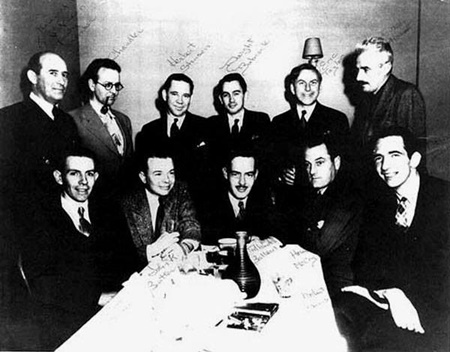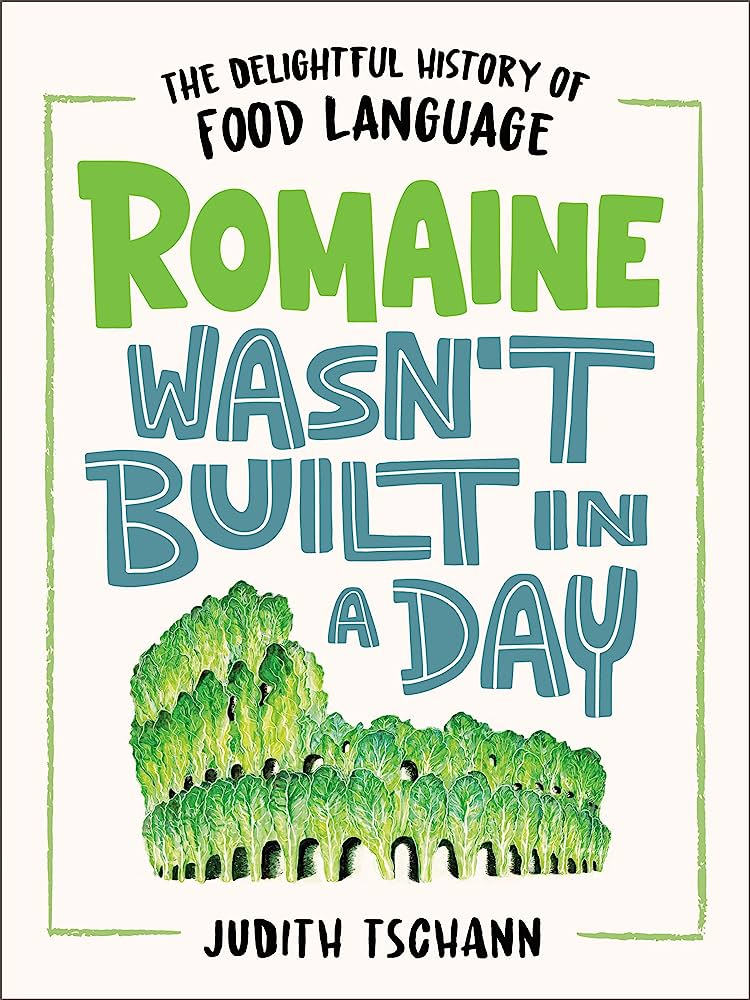
Romaine Wasn’t Built in a Day by Judith Tschann
The words that we use for food and eating say a lot about the history of the world and they ways that humans build culture. In Romaine Wasn’t Built in a Day, Judith Tschann, an emerita professor of linguistic and English, gives us the etymologies of hundreds of words for food and drink (I didn’t count—but the word index seems to be about 500). Tschann seasons the work with relevant linguistic concepts and Peter Grimm’s clever illustrations provide the garnish. We get not just the words from Old English (brēowa > brew, eyren > eggs, raedic > radish) and French (estuve > stew, dresser > dressing, ragoûter > ragout) but others like toddy (from Hindi), port (from Oporto, Portugal), ketchup (from Chinese) and yogurt (form Turkish). Bread, spaghetti, and eggs are staples and there is plenty to drink. Tschann is clearly having fun with the book and occasionally treats readers to some etymologies or food facts “Off the Menu.” It’s a great complement to Dan Jurafsky’s The Language of Food.
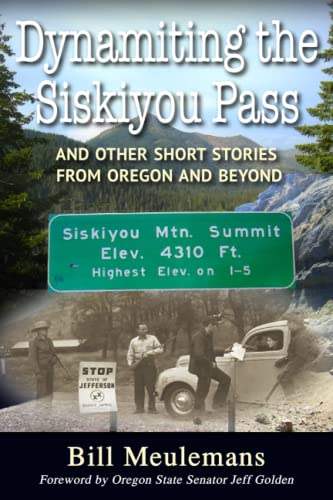
Dynamiting the Siskiyou Pass by Bill Meuelemans
Bill Meulemans is a political scientist who gets in the thick of his profession—in his 47 year career at Southern Oregon College, the University of Belfast, and Portland State University, he’s studied the mindsets of diverse political groups—mainstream and extreme in the US, Israel, and Northern Ireland. Dynamiting the Siskiyou Pass is a memoir of his experiences teaching and doing research in southern Oregon, Israel, and Belfast. Many of the stories are centered in Oregon where he taught for 28 years, had a radio show on Jefferson Public Radio, and worked as a political organizer. Meulemans invited extremists left and right to visit his classes and tell their stories, and he often researched groups by showing up at their meetings.
We learn about a group of right-wing patriots who practiced dynamiting the Siskiyou Pass separating California and Oregon–convinced that one day they would have to stop California Communists from invading. We hear about a planned protest and counter-protest over the raising of the campus flag after the Kent State killings which was thwarted by some quick-thinking campus maintenance workers. When members of the John Birch call for Meuelmans to be fired, he crashed their Christmas Party to set them straight. Meulemans visited the Rajneesh compound, interviewed the leader of Oakland’s Hell’s Angels, interviewed Ku Klux Klan members in Louisiana, and talked his way into the Soviet Embassy in Washington when he took students on a field trip. Meuelemans has also worked as a journalist, political organizer, and as a staff aide in the House of Representative, so the stories have a fast-paced journalistic tone rather than being ponderously academic. He offers more than just stories though. The memoir is filled his bits of political and sociological analysis—the role of empathy, single issue politics, the Hell’s Angels’ political views, and more. A first-rate memoir.
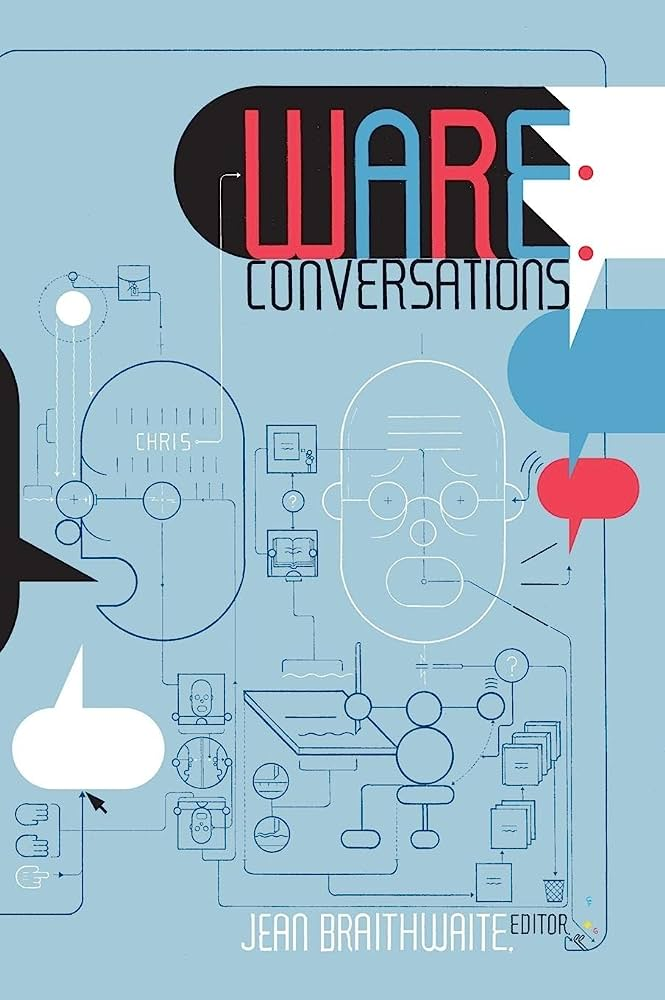
Chris Ware Conversations edited by Jean Braithwaite
I had not known about the University of Mississippi’s before I read this. It’s are series of carefully selected interviews with the Chris Ware—the author of Jimmy Corrigan, Building Stories, ACME Novelty Library and Rusty Brown. Spanning 25 years, the interviews bring us Ware unique voice, personal history, literary, his influences, and creative process. Bonus material includes Braithwaite’s interview with Marnie Ware, and Chris Wares own cover design, and over 40 illustrations from Ware’s work.
The Little Sleep by Paul Tremblay
Mark Genevich is a Boston private detective who suffers from narcolepsy and narcolepsy-related hallucinations, who starts unravelling a long-buried secret when the DA’s celebrity daughter appears in his office—or does she. Genevich evokes Jonathan Lethem and Raymond Chandler: Genevich is part Phillip Marlowe, part Lionel Essrog; And his mother is his helper. Some good plot twists and it all adds up in the end.
The Keeper of Lost Causes by Jussi Adler-Olsen
The first of the Department Q series, featuring Danish homicide detective Carl Mørck. Injured in a shooting that killed one colleague and paralyzed another, Mørck is promoted out of the way to head a cold case squad. But he discovered begins to suspect that a five-year old death has more to it that it seems. Good characters and a good plot, but I have to quibble about the somewhat unrealistic methods of the villain. I’ll definitely read more of this series.
The Golden State by Ben H. Winters
I’m a  big fan of Ben H. Winters’ world-building books (the Last Policeman Trilogy, Underground Airlines, etc.). In this one, he drops us into the future in the a “The Golden State” a dystopia where lies are illegal. Greetings are replaced by the recitation of facts “Two plus two is four”) and everyone tracks events in a collection of daybooks which one another by spouting facts. An elaborate system of tracking and archiving the minute details of everyone’s lives has been set up. The line between lies and other bits of speculation, imagination, and non-literalness is thin do a whole bureaucracy and enforcement arm are required to monitor and verify information. The enforcers of the truth are part of the Speculative Services, elite agents who can detect lies and are also licensed to speculate, hypothesize or lie themselves, in pursuit of the truth.
big fan of Ben H. Winters’ world-building books (the Last Policeman Trilogy, Underground Airlines, etc.). In this one, he drops us into the future in the a “The Golden State” a dystopia where lies are illegal. Greetings are replaced by the recitation of facts “Two plus two is four”) and everyone tracks events in a collection of daybooks which one another by spouting facts. An elaborate system of tracking and archiving the minute details of everyone’s lives has been set up. The line between lies and other bits of speculation, imagination, and non-literalness is thin do a whole bureaucracy and enforcement arm are required to monitor and verify information. The enforcers of the truth are part of the Speculative Services, elite agents who can detect lies and are also licensed to speculate, hypothesize or lie themselves, in pursuit of the truth.
This is their story. It’s centered around Laszlo Ratesic, a bulky loner with a unruly red beard and a failed marriage. As Laszlo explains it to his trainee:
“Unwarranted speculation is no better than lying, Ms. Paige. It is worse. You want to see how it’s done, here’s how it’s done: it’s better when it’s not done at all. Our job is to reinforce the Objectively So. Not conjure realities, every one of which might extend, evolve, metastasize.” “And none of those realities can be collected back once released. Our job is to find the facts and travel between them, walk carefully along the lines of what’s true. And when we do speculate? When we do hypothesize, we do it carefully, conscientiously, in a controlled environment, and we don’t do it at all unless and until the facts support it. The Speculative Service is a bulwark.”
And later “Shared understanding is a bulwark. Clear and agreed-upon definitions of common terms are defenses against infelicity. Words mean what they fucking mean.”
Laszlo discovers the truth about the truth and the state dedicated to maintaining it. What’s especially fun it’s the extent to which Winters has thought through the ideas about language. There is, for example, a Court of Small Infelicities, which deals with “knucklehead kerfluffles like when a car dealer is challenges about the truth of “lowest rates around.”
There is The Everyday Citizens’ Dictionary, where some words are redefined, such as novel: “A true story, that is, organized into chapters or incidents, featuring a historical character or characters, building to a conclusion, suggesting or implying an inspirational message about the nature of the Golden State.”
Humor is allowed, however:
”Humor causes no oscillation in the So, any more than any other form of small social falsehood: obvious hyperbole, inoffensive teasing, plain flattery—the whole constellation of innocuous and lubricating half-truths.” Idioms too are permitted “Given that their intention and literal meaning can be gleaned from context and familiarity. They’re like humorous remarks in that regard.”
Thought provoking stuff for linguistically-minded readers.

 Follow
Follow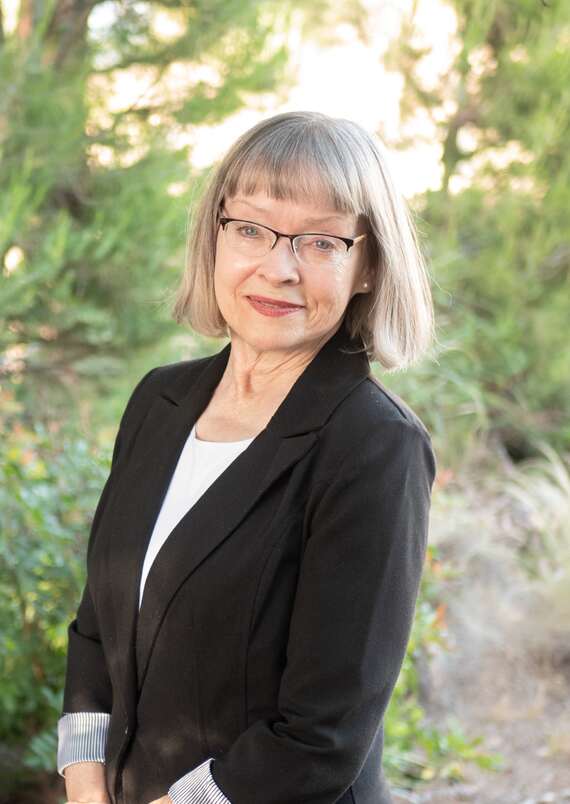
 JT: Souffle, pumpernickel, partridge, and nuns’ farts come to mind, because they illustrate different aspects of lexical evolution or semantic change, as well as the difficulty of fully accounting for a word’s history and meaning. The Latin word flāre, “to blow,” gave us a many words, including flavor, flatulence, conflate, deflate, inflate, and (via French) souffle. Even if some members of this group of related words seem almost contradictory, it’s still possible to see how they could all come from a word meaning “to blow.” But with food terms like pumpernickel, partridge, and nuns’ farts, it’s not a matter of how words with very different meanings can derive from the same ancestor word, but rather a question of how some foods ever acquire a seemingly unappealing name, one that suggests yucky rather than yummy. The why and how of the name are often a matter of speculation.
JT: Souffle, pumpernickel, partridge, and nuns’ farts come to mind, because they illustrate different aspects of lexical evolution or semantic change, as well as the difficulty of fully accounting for a word’s history and meaning. The Latin word flāre, “to blow,” gave us a many words, including flavor, flatulence, conflate, deflate, inflate, and (via French) souffle. Even if some members of this group of related words seem almost contradictory, it’s still possible to see how they could all come from a word meaning “to blow.” But with food terms like pumpernickel, partridge, and nuns’ farts, it’s not a matter of how words with very different meanings can derive from the same ancestor word, but rather a question of how some foods ever acquire a seemingly unappealing name, one that suggests yucky rather than yummy. The why and how of the name are often a matter of speculation. Bill Meulemans is an emeritus professor of political science at Southern Oregon University, where he taught from 1964-1992. A former Danforth Fellow, Fulbright scholar, and Army veteran, he has a PhD from the University of Idaho and also taught at Queen’s University in Belfast, and at Portland State University.
Bill Meulemans is an emeritus professor of political science at Southern Oregon University, where he taught from 1964-1992. A former Danforth Fellow, Fulbright scholar, and Army veteran, he has a PhD from the University of Idaho and also taught at Queen’s University in Belfast, and at Portland State University.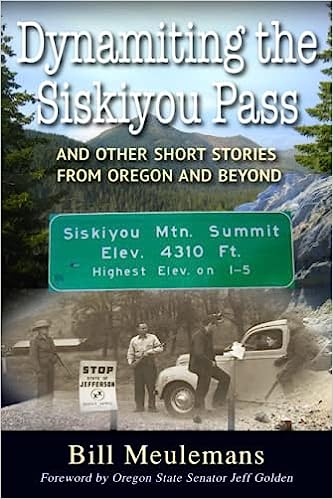 Bill Meulemans: The killing by the Ohio National Guard of four unarmed students in 1970 at Kent State University sent political shock waves to college campuses across the country. In response, students a Southern Oregon College in Ashland decided that the US Flag should fly on campus at half-mast the next day in commemoration of the those killed at Kent State. When word of this leaked out to the right-wing non-student population a determination was made by them to be ready to use any means available to raise the Flag to full-mast. Early the next morning a small fleet of pickup trucks with gunracks in the back windows showed up to raise the Flag despite the unarmed students who, by this time, were afraid for their lives. At this point it looked like another “Kent State” was in the offing. But when the Flag was attached to the rope, it was discovered that the pulley had been smashed, perhaps by a hammer. The students were relieved, the fleet of pickup trucks left, and everyone breathed a little easier. Several days later everyone on the campus found out that two unnamed college maintenance men had smashed the pully to “save us from ourselves.” These state workers became local heroes, demonstrating that maybe a bit of common sense had saved some lives that morning on a small college campus in Oregon.
Bill Meulemans: The killing by the Ohio National Guard of four unarmed students in 1970 at Kent State University sent political shock waves to college campuses across the country. In response, students a Southern Oregon College in Ashland decided that the US Flag should fly on campus at half-mast the next day in commemoration of the those killed at Kent State. When word of this leaked out to the right-wing non-student population a determination was made by them to be ready to use any means available to raise the Flag to full-mast. Early the next morning a small fleet of pickup trucks with gunracks in the back windows showed up to raise the Flag despite the unarmed students who, by this time, were afraid for their lives. At this point it looked like another “Kent State” was in the offing. But when the Flag was attached to the rope, it was discovered that the pulley had been smashed, perhaps by a hammer. The students were relieved, the fleet of pickup trucks left, and everyone breathed a little easier. Several days later everyone on the campus found out that two unnamed college maintenance men had smashed the pully to “save us from ourselves.” These state workers became local heroes, demonstrating that maybe a bit of common sense had saved some lives that morning on a small college campus in Oregon.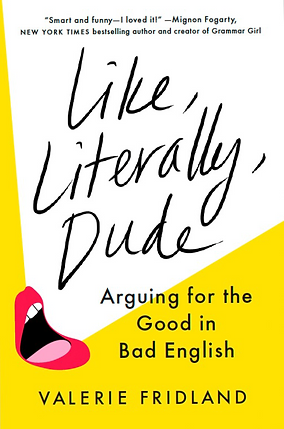 Like, Literally, Dude is one of those books that makes me wish I was still teaching, so I could assign it. Fridland, a professor of linguistics at the University of Nevada, Reno, brings together the research on just about all of the bits of usage that your misinformed, snooty relatives rant about: the use of uh and um, the use of like, vocal fry, saying workin’ rather than working, referring to any manner of dudes and, of course, the much-maligned figurative use of literally. I learned new things about each of these phenoms. What’s more, Fridland writes in an engaging and funny manner without stinting on linguistic accuracy. So before you opine about anyone’s bad English—or fret about your own—give Like, Literally Dude, a read.
Like, Literally, Dude is one of those books that makes me wish I was still teaching, so I could assign it. Fridland, a professor of linguistics at the University of Nevada, Reno, brings together the research on just about all of the bits of usage that your misinformed, snooty relatives rant about: the use of uh and um, the use of like, vocal fry, saying workin’ rather than working, referring to any manner of dudes and, of course, the much-maligned figurative use of literally. I learned new things about each of these phenoms. What’s more, Fridland writes in an engaging and funny manner without stinting on linguistic accuracy. So before you opine about anyone’s bad English—or fret about your own—give Like, Literally Dude, a read.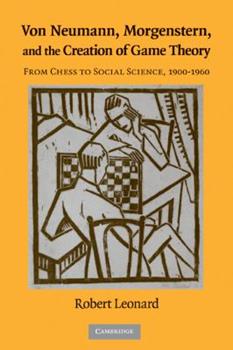 Von Neumann, Morgenstern, and the creation of game theory: from chess to social science, 1900–1960 by Robert Leonard,
Von Neumann, Morgenstern, and the creation of game theory: from chess to social science, 1900–1960 by Robert Leonard, 